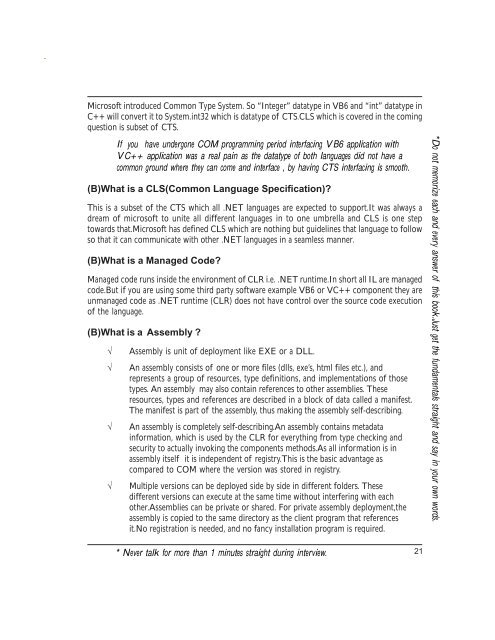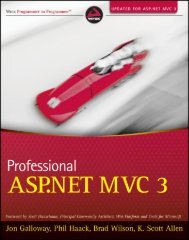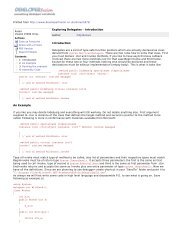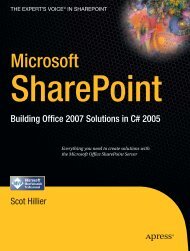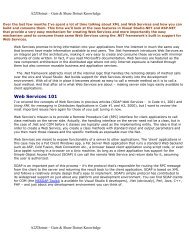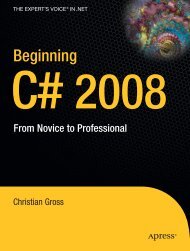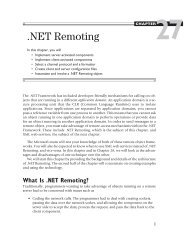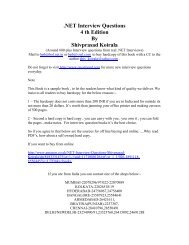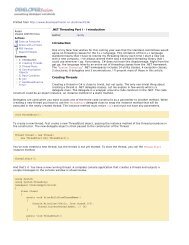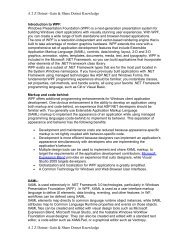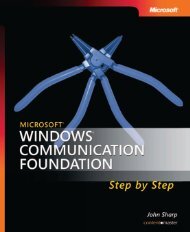DOT NET Interview Questions - DotNetSpider
DOT NET Interview Questions - DotNetSpider
DOT NET Interview Questions - DotNetSpider
You also want an ePaper? Increase the reach of your titles
YUMPU automatically turns print PDFs into web optimized ePapers that Google loves.
Microsoft introduced Common Type System. So “Integer” datatype in VB6 and “int” datatype in<br />
C++ will convert it to System.int32 which is datatype of CTS.CLS which is covered in the coming<br />
question is subset of CTS.<br />
If you have undergone COM programming period interfacing VB6 application with<br />
VC++ application was a real pain as the datatype of both languages did not have a<br />
common ground where they can come and interface , by having CTS interfacing is smooth.<br />
(B)What is a CLS(Common Language Specification)?<br />
This is a subset of the CTS which all .<strong>NET</strong> languages are expected to support.It was always a<br />
dream of microsoft to unite all different languages in to one umbrella and CLS is one step<br />
towards that.Microsoft has defined CLS which are nothing but guidelines that language to follow<br />
so that it can communicate with other .<strong>NET</strong> languages in a seamless manner.<br />
(B)What is a Managed Code?<br />
Managed code runs inside the environment of CLR i.e. .<strong>NET</strong> runtime.In short all IL are managed<br />
code.But if you are using some third party software example VB6 or VC++ component they are<br />
unmanaged code as .<strong>NET</strong> runtime (CLR) does not have control over the source code execution<br />
of the language.<br />
(B)What is a Assembly ?<br />
√<br />
√<br />
√<br />
√<br />
Assembly is unit of deployment like EXE or a DLL.<br />
An assembly consists of one or more files (dlls, exe’s, html files etc.), and<br />
represents a group of resources, type definitions, and implementations of those<br />
types. An assembly may also contain references to other assemblies. These<br />
resources, types and references are described in a block of data called a manifest.<br />
The manifest is part of the assembly, thus making the assembly self-describing.<br />
An assembly is completely self-describing.An assembly contains metadata<br />
information, which is used by the CLR for everything from type checking and<br />
security to actually invoking the components methods.As all information is in<br />
assembly itself it is independent of registry.This is the basic advantage as<br />
compared to COM where the version was stored in registry.<br />
Multiple versions can be deployed side by side in different folders. These<br />
different versions can execute at the same time without interfering with each<br />
other.Assemblies can be private or shared. For private assembly deployment,the<br />
assembly is copied to the same directory as the client program that references<br />
it.No registration is needed, and no fancy installation program is required.<br />
*Do not memorize each and every answer of this book.Just get the fundamentals straight and say in your own words.<br />
* Never talk for more than 1 minutes straight during interview.<br />
21


